
Tycoon
Definition:
1) a top leader (as in politics)
2) a businessperson of exceptional wealth and power : magnate
They become tech tycoons by creating a media platform on which unpaid users do the work, for hours every day, and they sell ads against it.
— Mary McNamara, The Los Angeles Times, 18 Apr. 2022
While tycoon now most often refers to a very wealthy and powerful businessperson, the word has had two other uses in English as well.
When the United States forced Japan to open full commercial and diplomatic relations with the West in 1854, the real ruler of the island nation was the shogun. Officially only a military deputy of the emperor, the shogun—a title shortened from seii-taishōgun, meaning “barbarian-subjugating generalissimo”—stood at the pinnacle of a feudal hierarchy based at Edo (later Tokyo) that effectively controlled the imperial court at Kyoto and ruled the country. Westerners in the initial period of diplomatic relations concluded that the shogun was a sort of secular emperor and the emperor something like the pope. Townsend Harris, the first American consul to Japan, got the idea that the shogun's correct title was taikun, a Japanese borrowing from Middle Chinese elements equivalent to Beijing Chinese dà “great” and jūn “prince.” This word, in the spelling tycoon, became quite popular in America immediately before and during the Civil War as a colloquialism meaning “top leader” or “potentate.” (John Hay, President Lincoln's personal secretary—and later Secretary of State to Presidents McKinley and Theodore Roosevelt—referred to Lincoln as "the Tycoon.") After fading from use for several decades tycoon was revived in 1920s journalism with the narrower sense “a businessman of exceptional wealth and power,” a usage that continues to be part of English.

Honcho
Definition: a person who is in charge of other people : boss, big shot; also : hotshot
Head honcho Simon Cowell was back behind the judging table, having missed much of the 2020 contest after breaking his back in an e-bike crash.
— Michael Hogan, The Telegraph (London, Eng.), 16 Apr. 2022
Honcho dates back—in English—to at least 1945, as World War II was coming to a close. American prisoners learned the word while in captivity in Japan. In Japanese, the word translates as "squad leader," from han, meaning "squad," and chō, meaning "head, chief." Not long after the war ended, in 1952, General Eisenhower himself was called the "chief honcho" in the Los Angeles Times. Often the word appears in the mildly redundant but pleasantly alliterative phrase head honcho.
MORE: Top Banana, Kingpin, and Other Nicknames for Important People

Kudzu
Definition: a fast-growing Asian vine (Pueraria lobata) of the legume family that is used for forage and erosion control and is often a serious weed in the southeastern United States
The kudzu vine, I’m told, grows about an inch an hour. That’s crazy fast. A single kudzu strand can stretch a hundred feet, which is probably twice as high as the trees it clings to.
— Robert Krulwich, National Geographic, 12 Apr. 2016
Anyone who's lived in or visited the southeastern U.S. is familiar with kudzu. It's that thick mass of green that can be spotted climbing up trees and overtaking abandoned buildings and anything else in its path. The plant is native to China and Japan, and was transplanted to North America to help prevent erosion, but it's since become a bit of a menace. The word kudzu is still perfectly nice, though. It comes from Japanese kuzu, and has been in use in English since at least 1876.
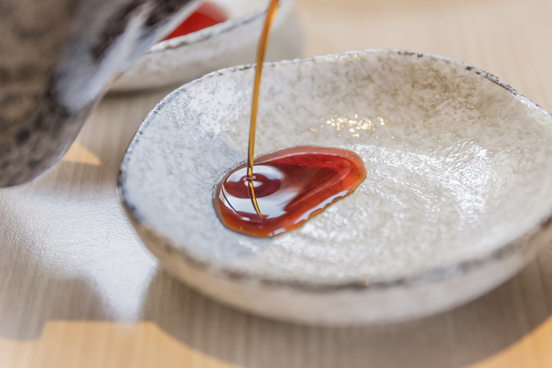
Skosh
Definition: a small amount : bit, smidgen —used adverbially with a
Here's one way to look at it: Rick Nash, one of the most feared goal scorers of his generation, had 437 goals in his 16 years in the NHL, which means he got a skosh more than halfway toward Gretzky's 894.
— Michael Arace, Marion Star (Marion, OH), 12 Mar. 2022
Skosh is another word introduced into English by U.S. soldiers, though this time those soldiers learned the word while stationed in Japan after World War II had ended—our earliest evidence of it in use in English is from 1952. Our word skosh comes from Japanese sukoshi, which is pronounced \skoh-shee. Sukoshi is translated as "a tiny bit" or "a small amount," making our word skosh identical in meaning to its parent word. The English word, however, is also sometimes used adverbially with a, as in "I'm fine, just a skosh tired."
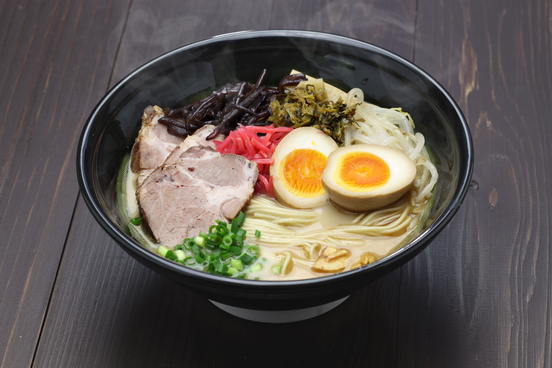
Ramen
Definition: quick-cooking egg noodles usually served in a broth with bits of meat and vegetables
If you’ve never had real ramen before, please allow me a moment to describe the deliciousness. Picture fresh-cooked noodles, rich, savory broth, the perfect amount of spice, and if you want, a few slices of pork and a half-cooked egg.
— Geoffrey Morrison, Forbes, 30 May 2016
Early evidence dates the word ramen in English to 1962, which makes it only a few years younger than the word in Japanese—though the dish itself dates to the 19th century when Chinese workers brought it to Japan. First called Shina soba (Shina is a term for China now disfavored by many; soba refers to noodles made from buckwheat flour—though ramen seems always to have been typically made from wheat-based noodles), the dish was called rāmen in Japan starting in the post-World War II years, from the Chinese (Pekingese) la (meaning "pull") and mien meaning "noodles." Ramen was also called Chūka soba for a time. (Chūka is a form of Chūgoku, another name for China.)

Futon
Definition: a usually cotton-filled mattress used on the floor or in a frame as a bed, couch, or chair
My good deed paid off a few days later when I went shopping online and bought a used futon with three legs (technically it has four legs but one was snapped off).
— Chuck Brown, Waterloo Region Record (Kitchener, Can.), 10 Nov. 2018
A staple of small apartments, dorms, and guest quarters everywhere, the versatile futon has been part of our home furnishing vernacular for a long time. The word itself has been used in English since the late 1800s. While English speakers think of a futon as something you sleep (or sit) on, not under, the word in Japanese can also refer to a thick comforter, though the word kakebuton is the more typical word in that context.

Sudoku
Definition: a puzzle in which several numbers are to be filled into a 9x9 grid of squares so that every row, every column, and every 3x3 box contains the numbers 1 through 9
A juror in Elizabeth Holmes's criminal fraud trial was dismissed Friday after telling the judge she was playing Sudoku for around half of the trial days to help her stay focused, according to a court transcript.
— Sara Randazzo, Dow Jones Institutional News (New York, NY), 22 Oct. 2021
The first sudoku-type puzzle was called a "Number Place" puzzle, and it appeared in a 1979 New York-based puzzle magazine. Five years later, the puzzles started to appear in Japan where they were dubbed Sudoku, short for sūji wa dokushin ni kagiru, meaning “the numerals must remain single” (i.e., the digits can occur only once). Sudoku puzzles—and the word sudoku itself—didn't start appearing in English publications until the early part of this century.
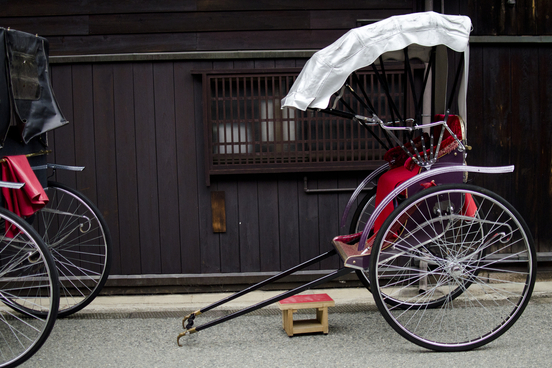
Rickshaw
Definition: a small, light vehicle with two wheels that is pulled by one person on foot or on a bicycle and that is used in some Asian countries
Fisher writes of an American psychology grad student attending a conference in Beijing. He had a mad crush on another student. He invited her for a rickshaw ride, knowing that novelty and danger can trigger the dopamine system—goosing the potential for falling in love.
—Mackenzie Dawson, The New York Post, 22 May 2016
The English word rickshaw, also spelled ricksha, originally had another syllable out front: jinricksha (also spelled jinrikisha). That word comes directly from Japanese, where jin means "man," riki means "strength" or "power," and sha means "carriage." Rickshaws originated in Japan, where they were first used in the late 1800s. They're now common in many parts of Asia as well as in a number of cities in the U.S.

Hunky-dory
Definition: quite satisfactory : fine
When you're safe at "home" in the game of tag, it can be said that "everything's hunky-dory"—since you can't be tagged there. The first part of the word hunky-dory is derived from a homograph of hunk, a now-obsolete word of New York dialect meaning "goal" or "home" that has connections to tag.
Tag is sometimes rendered more complicated by certain places which are called "hunks" or "homes" being agreed upon where the players may find refuge when closely pursued.
—The Journal of American Folk-lore, 1891All was not well between Benitez, Tom Hicks and George Gillett 15 years ago and indeed, all might not be hunky-dory now between Salah and the club while his contract remains unresolved.
— Theo Squires, Liverpool Echo (Liverpool, Eng.), 10 Apr. 2022
Hunk is from Dutch honk, meaning "home," and in the 19th century, both hunk and hunky evolved into adjectives meaning “all right” or "safe and sound." How the adjective came to be partnered with dory is a mystery, but one theory is that it was brought to the States by sailors stationed in Japan. Supposedly there was a thoroughfare in 19th-century Japan that sailors frequented and described as being hunky, meaning "satisfactory." The pronunciation of the Japanese word for "road" is similar to "dory," and the sailors could have combined the English and Japanese terms as an allusion to the "satisfactory" street.
Though hunk and hunky were already established in America when hunky-dory made its appearance (remember, even old New York was once New Amsterdam), there is no sure evidence linking the term to American sailors in Japan. As of now, the term's true origins remain a mystery.

Anime
Definition: a style of animation originating in Japan that is characterized by stark colorful graphics depicting vibrant characters in action-filled plots often with fantastic or futuristic themes
In Japanese, the word anime is a shortening of animēshiyon, which is based on English animation, and refers to animated films and shows from around the world, not just from Japan. When English speakers adopted anime in the 1980s, however, it was as a name to refer to specifically Japanese animation and animation done in a similar style.
Our cosplay readers might be interested to know that in the past anime was the name for a cuirass (a piece of armor covering the body from neck to waist) or its breastplate―a must-have for the medieval or fantasy warrior. The name is of French origin and is more than likely from Italian anima, meaning "life" or "soul":
A'nima, the soule of mankind. Also the core of kernell of any fruit. Also a cuirace or brestplate, so called because it armeth the heart.
― John Florio, Queen Anna's new world of words, or dictionarie of the Italian and English tongues, 1611
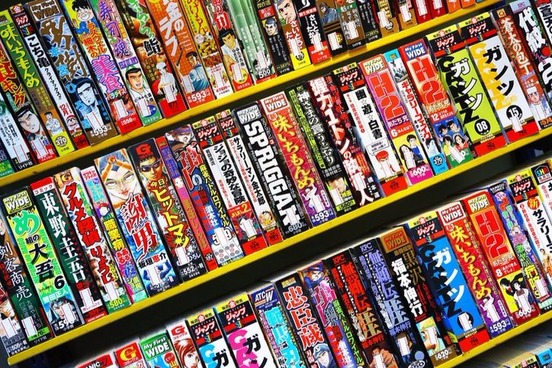
Manga
Definition: Japanese comic books and graphic novels
Japanese manga is a combination of man-, meaning "involuntary, aimless," and -ga, "picture." The first appearance of this word for "involuntary pictures"―or rather, illustrations made impulsively or randomly―is not known, but it seems to have been drawn up in the 18th century.
In the 19th century, it was popularized in its early form mangwa as the title of a collection of sketches by Japanese artist Katsushika Hokusai. The word in the title is meant in its literal sense as the drawings were of random subjects and themes.
In the early-20th century, the Japanese term came to designate comic books, and about mid-century, manga was borrowed into English in that sense. As we see with anime, the Japanese use the term for comic books in general, while English speakers apply it to the meticulously-drawn Japanese comics.
Manga is huge among young Koreans; K-Pop is big in Japan; Korean films are hot news everywhere.
— Sydney Morning Herald (Sydney, Aus.), 18 Apr. 2022
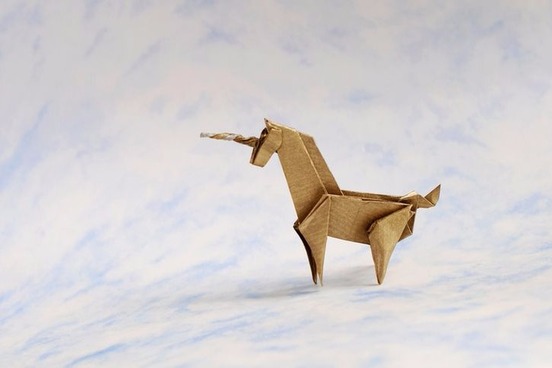
Origami
Definition: the Japanese art or process of folding squares of paper into representational shapes
Origami is a compound of two Japanese words, namely, ori, meaning "fold," and kami, "paper." The etymology of the word seems straightforward until closer inspection reveals a slight wrinkle: in Japanese, origami was already used to refer to a folded certificate or document of authentication. So why the change?
Earlier Japanese names for the art include orikata, orisue, and orimono. It only came to be called origami in the 20th century, leading some to suggest that its use is linked to Japan's kindergarten movement in the late-19th century (proposing that the word was easier to spell for schoolchildren). Others point to the fact that the art form was flourishing in other countries and origami was chosen because its base words reflect names like English paper folding and German Papierfalten. Both speculations seem reasonable, but the motivation for the initial change is still unclear.
“WITH so many sporting events being cancelled they’re having to televise the World Origami Championships,” says reader Deborah Raven, who adds: “It’s on Paperview.”
— The Herald (Glasgow, Scot.), 14 Apr. 2020

Yakuza
Definition:
1) a Japanese gangster
2) an organized crime syndicate in Japan
The name yakuza originates from the Japanese card game oicho-kabu in which the goal is to draw three cards adding up to a value of 9. Like in baccarat, the last digit of any total over 10 is the value of the hand. Thus, the worst possible draw in the game is 8-9-3, which totals 20 and results in 0 for the play. In Japanese, the phonetic spelling of the draw is "ya" (8), "ku" (9), "za" (3). Associating this worst hand with the worst of society, people began referring to Japanese gangsters and racketeers as the yakuza.
At a news conference in Dublin, Greg Gatjanis, an associate director of the Treasury's Office of Foreign Assets Control, compared the Kinahan group to the Camorra in Italy, the yakuza in Japan and Los Zetas in Mexico.
— Kevin Draper, The New York Times, 13 Apr. 2022
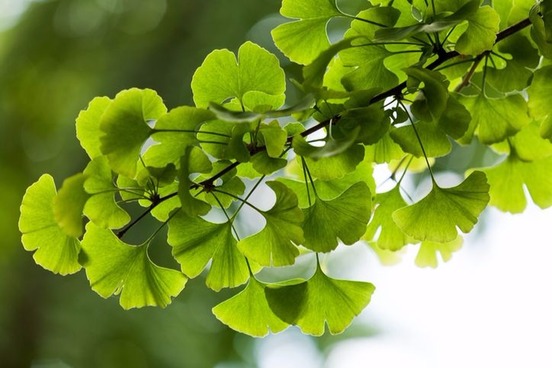
Ginkgo
Definition: a gymnospermous dioecious tree (Ginkgo biloba) of eastern China that is widely grown as an ornamental or shade tree and has fan-shaped leaves and foul-smelling yellowish fleshy seed coats — called also maidenhair tree
The ginkgo tree was formerly known as the maidenhair tree in reference to the tree's distinctive fan-shaped leaves. The name ginkgo is from Japanese ginkyō, a word ultimately from Chinese words that translate as "silver apricot." The second g in English ginkgo is from an erroneous transcription of ginkyō that has been perpetuated in scientific writing. Occasionally, you might encounter a misspelling of the misspelled ginkgo that misunderstands the word as gingko.
The one-mile loop around the lake immerses visitors in various gardens attracting a variety of butterflies and dragonflies, and arboretums with oak, elm, gingko, hickory and other trees.
— Chicago Tribune, 21 May 2017
The tree is also commonly known by its scientific name: ginkgo biloba. Biloba means "having two lobes," in reference to the shape of the its leaves.

Tanka, Haiku, and Senryu
Tanka, from Japanese tan ("short") and ka ("song"), refers to an unrhymed Japanese verse of five lines containing five, seven, five, seven, and seven syllables respectively.
The far meeting point
Of the sea and the pale sky
Trembles in the haze.
The warm sleeping dunes exhale
The remains of the summer.
— Hisashi Nakamura
Although its name translates as "short song," it is longer than the more familiar haiku, which has three lines containing usually five, seven, and five syllables respectively.
An old silent pond …
A frog jumps into the pond,
Splash! Silence again.
— Matsuo Basho
Another type of Japanese verse is senryu, a 3-line unrhymed poem that is structurally similar to haiku. However, whereas haiku tends to focus on nature and the seasons and usually has a serious tone, senryu tends toward irony and satire, especially about the human condition.
his favourite deli—
the bald man finds a hair
in his soup
— Michael Dylan Welch

Emoji
Definition: any of various small images, symbols, or icons used in text fields in electronic communication (as in text messages, e-mail, and social media) to express the emotional attitude of the writer, convey information succinctly, communicate a message playfully without using words, etc.
In the 1980s, emoticons—symbols formed using keyboard characters, like ;-) to indicate a joke or, you know, a wink—were crafted by creative typists. Building on their popularity, computer techs began designing images and symbols to graphically encapsulate the emotion of the emoticon. They became known as emojis, and people have been animating their electronic messages with them since the 1990s.
The name comes from Japanese moji, meaning "letter, character," and e, based on ancient Japanese ye, meaning "picture, drawing" (not "emotion").
The day after Ben received the Calvert Hall offer, Good Counsel and DeMatha emailed acceptance letters. A Calvert Hall coach, meanwhile, messaged Ben five eyeball emoji on Twitter.
— Kyle Melnick, The Washington Post, 18 Apr. 2022
PLAY: Take the Emoji Quiz
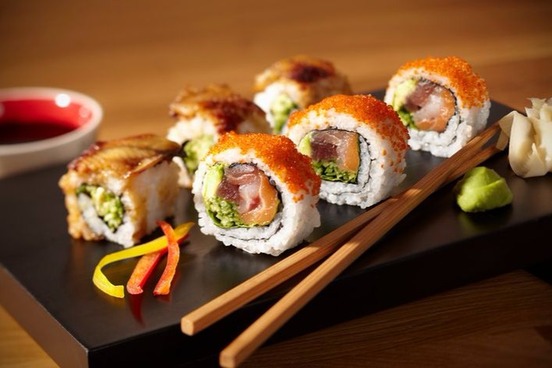
Sushi
Definition: cold rice dressed with vinegar, formed into any of various shapes, and garnished especially with bits of raw seafood or vegetables
Gastronomes of Japanese food know that sushi—a blend of Japanese su ("vinegar") and meshi ("rice")—refers to vinegared rice and that a sushi entree only includes raw fish if requested. But the pairing of sushi and raw fish is common, and for many unacquainted with Japanese cuisine, that is what sushi means, "raw fish." Evidence of this colloquial misuse is not hard to find.
… sushi are tiny parcels of rice rolled up in seaweed that may or may not contain raw fish. "They're more of a sandwich format," says Stuart [Turner]. "I get so tired of people saying 'erh, raw fish' that I feel like having 'sushi is not raw fish' tattooed on my forehead."
— The Huddersfield Daily Examiner, 14 Sept. 2017I don't eat sushi, but I eat cooked meat.
— Drake Bell, Seventeen, 21 Sept. 2008
For those looking for a Japanese term for "raw fish," try sashimi, the Japanese name for just that. It is a combination of sashi ("pierce") and mi ("flesh"), and although sashimi is not pierced when prepared, it is sliced.

New Japanese Words
Here are a few new Japanese words we've been watching.
- On 'Kawaii' and the Power of Cute
- What Does 'Otaku' Really Mean?
- Noticing 'Senpai'




